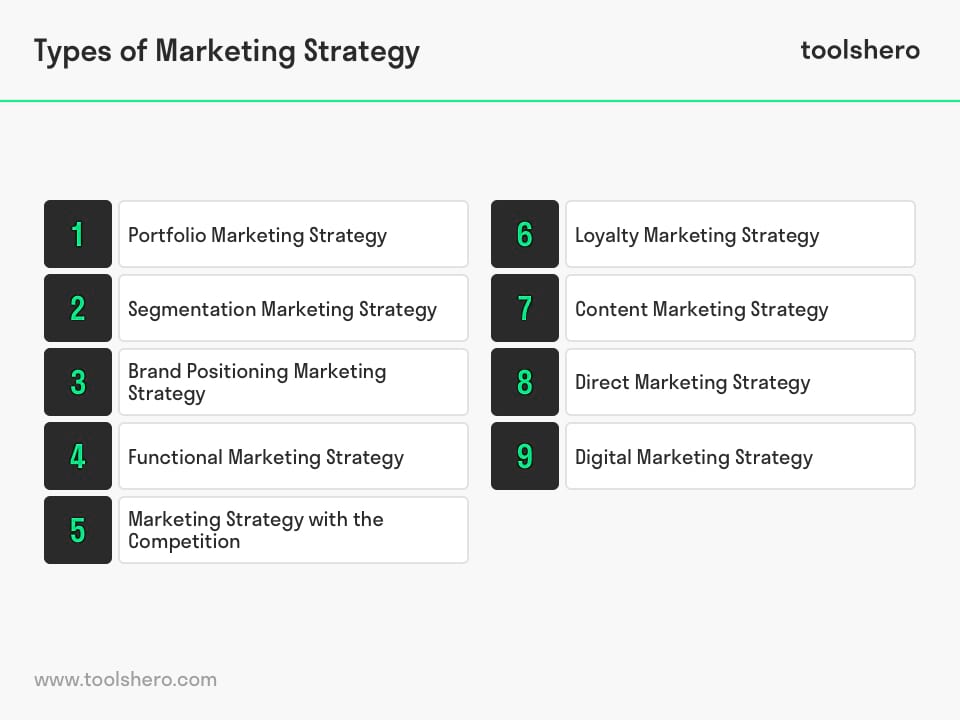Marketing Strategy: the Definition, Theory and Types

Marketing Strategy: this article explains the Marketing Strategy in a practical way. Next to what it is (definition), this article also highlights the importance, Marketing Strategies versus a Marketing Plan, how to develop a strategy, the types and a short summary. After reading, you will understand the basics of this great tool for achieving business objectives. Enjoy reading!
What is a Marketing Strategy? The definition and theory
A Marketing Strategy can be defined as the long term planning of business objectives that the company wants to achieve. For these to be achieved, it is important to choose the specific actions to consolidate the reputation of products and services or increase sales in the market.
Utilizing opportunities is vital to find the target market and to be able to make make customers loyal to the organization so that the positioning of the company gets stronger.
It is important to define how you want to position the product / service in the market in order to achieve positioning among customers and fulfil customer and organization relationship loyalty.
It is the method to create sales opportunities, also to communicate and position the product or service and to translate the operational lines that allow reaching a target market through the right channels.
The answer to “what is marketing strategy?” can both be similar and different for each company.
Generally, marketing strategy in definition is the plan a company has to promote and sell their product or service.
It is a plan that is employed to reach potential consumers and convert them into loyal consumers of the product or service. You can define and explain marketing strategy from the point of view of the company with a focus on either the product or service, or with a focus on the potential consumers.
In whichever way you define marketing strategy, the definition of the concept remains the same while new strategies are developed. The marketing mix is one way to map and organise a marketing strategy.
There are four elements that make up the marketing mix, in which the 4ps of marketing are found to shape the crucial strategies to generate profits in the company and boost sales:
- Product strategies
- Pricing strategies
- Distribution strategies
- Promotion strategies
Importance of having a Marketing Strategy in your business
Choosing a suitable marketing strategies for the company will bring great advantages such as:
- Increased sales
- Creating sustainable growth for the company
- Understanding what your customers want
- You will meet the needs and exceed the expectations of the customers
- You will strengthen the relationship with the target market
- You will build the brand in the consumer’s mind
Marketing Strategies vs. Marketing Plan
In order to formulate strategies, it is necessary to have the marketing objectives in mind, since strategies must be implemented to achieve these objectives; but also the consumers that make up the target market, the competition, the resources and capabilities of the company.
It is important that before identifying and formulating the strategies, the difference between the marketing strategy and the marketing plan must be considered, since it can generate confusion about these two concepts that go hand in hand but are focused differently
Marketing Strategy
Is the explanation of the objectives to be achieved with a company’s marketing efforts (what). These strategies are determined by the company’s objectives. Goals and strategy must go hand in hand.
The strategies must allow needs, desires, problem solving or take advantage of habits and customs that the target audience has.
Marketing Plan
This is how you’re going to achieve those marketing goals (how). It is the map that will guide you from one point to another of the desired situation (objectives).
Example
Objective: To achieve a higher market share.
Marketing Strategy: Enter a new market segment.
Market Plan: Develop a marketing campaign that reaches, identifies and focuses on the specific segment.
Marketing Strategy -> Marketing Plan-> Implementation = Successful Marketing Strategy
How to develop an effective marketing strategy?
For an effective marketing strategy it is necessary to know your competition and know that what you offer to your clients has the added value that the competition does not have (FAB ANALYSIS- features, advantages and benefits).
After this define your target market in a demographic and psychographic way, this will help to know why they need to buy products / services from you.
There are several ways to make marketing strategies effective, so it is necessary to focus on the most important communication channels (traditional and virtual media) and to be able to carry out the strategies with a successful follow-up of the implementation of the strategies.
Additionally, optimizing your online presence is crucial in this regard. One effective tactic is understanding and leveraging platforms where you can increase your YouTube views like Views4You, which plays a crucial role in achieving success in digital marketing.
Establish the objectives and the process:
- Analyse the position in the market: identify the target audience, the competition and what is happening in the company. In addition, define which are the strong aspects and those that you should optimize
- Establish goals: create achievable brand and sales objectives and determine the time frame to reach them
- Design the tactics: after you examine the landscape, create the lines of action based on the strategies you know
- Implement controls: define how you will measure goal achievement and how you expect performance to gradually improve
Types of Marketing Strategy

Figure 1 – Types of Marketing Strategy
Portfolio Marketing Strategy
Analyse which products are sold and which are not in order to decide which ones are still on the market and continue with their manufacturing process since keeping the products that are not generating economic income must be discarded.
Segmentation Marketing Strategy
This strategy is to decide which segments the market has been classified into. The segmentation can be of three types:
- Differentiated: when addressing each of the market segments that have been identified with a different offer and positioning. This strategy has a higher cost, but it will allow to satisfy the specific needs of each selected segment
- Undifferentiated: segments with different needs are identified, but the company chooses to address them with the same offer, in order to try to get the largest number of customers
- Concentrated: only one of the market segments is chosen. This avoids making efforts in other segments and allows the campaign to be focused. This is the most effective strategy for companies that are growing
The segmentation strategy is derived from previous market research in order to classify the segments and make good decisions about them.
Brand Positioning Marketing Strategy
This strategy consists of defining how the brand wants to be perceived in the strategic segments decided, what attributes we want to have as a company or brand in the mind of the consumer.
There are several ways to access the positioning in comparison to the competition and it can be with the product’s cover, the company’s image, the characteristics and uses of the product.
The main marketing strategies on positioning are:
- Benefit: this strategy is based on positioning the product for the benefit it offers
- Quality/price: offering the highest quality at a competitive price
- Attributes: position the product by the attributes it has
- Use / application: position based on the use or application given to the product
- Categories: position yourself as a leader in a product category
- Competitor: compare your products with those of your competitors, this is a classic strategy
When we talk about positioning strategy as a concept, we must take into account that we are designing three different strategic marketing keys: the positioning of the company, the positioning of the brand and the positioning before the consumer.
Functional Marketing Strategy
This strategy is formed by the strategies of the marketing mix or also called the 4Ps of marketing are variables of great importance to achieve the commercial objectives that the organization has. The 4 variables are product, price, distribution and promotion.
- Product: brand, image, warranty, after-sales services among others
- Price: modification of prices, discount scales, payment conditions etc.
- Distribution: packaging, storage, order management, inventory control, point of sale location and transport
- Promotion: internal and external communication, supports and media
Marketing Strategy with the Competition
This strategy focuses on competitive value. You must define where you are in the market compared to your competition.
- If you are above your competitors, maintain that position
- If you are below the competition, scale your position
- If you are below, you can also stay there, in case fighting for a higher place is counterproductive
Loyalty Marketing Strategy
It will maintain customer loyalty. It will prevent them from leaving with the competition thanks to the constant creativity and good customer service that the company will provide to its consumers. It can include discounts, promotions, gifts, etc.
Content Marketing Strategy
Content Marketing and this strategy is based on the creation of content such as: articles, computer graphics, ebooks. This type of strategy can be used as a blog where you can:
- Publish news, trends and information about the company or specific product
- Reviews
- Educate the customer about the product/service
Direct Marketing Strategy
A direct-customized message is implemented with the client. The consumer values the fact that the company communicates in a personal way for him / her as close ties are created.
Digital Marketing Strategy
Today most companies do digital marketing something that was not common several years ago. Being just one click away from information makes this strategy popular.
The following can be applied:
- Inbound marketing, used to attract and convert customers organically through useful SEO content writing
- Mailing where segmented communication can be established
- Social networking to connect your posts with customers
- Web search engines to make the brand appear in the first options, among others
With the type of strategies mentioned you can visualize what objectives you want to achieve and what results you want to bring to your company in a short term.
Conclusion
A marketing strategy is a type of strategy with which each business unit plans to achieve its marketing objectives by:
- Selecting the target market you want to reach
- The definition of the positioning you will try to achieve in the minds of your target customers
- The choice of the marketing combination or mix (product, distribution, price and promotion) with which you intend to meet the needs or desires of the target market
- The determination of marketing expenditure levels
In order to develop the marketing plan, it is important to first choose the marketing strategy for the long-term objectives of the company. For this you can accompany yourself by creating SMART Goals, performing a SWOT Analysis or FAB Analysis, among other methods to structure well what you want to do, how you should do it and what results you could obtain.
Some of the traditional strategies that are still widely used by organizations today. However, the world is in a constant media development so companies have also felt the pressure to use other types of marketing strategies to survive and transform the processes of change, this is why the importance of digital marketing strategies.
The company must adapt to changes in technological development, communication channels, customer mentality and different processes that today’s world moves fiercely.
Not all organizations carry out market strategies in the same way. Just as there is diversity of people, there is diversity of brands, and each of them has particular preferences and needs. Choose the strategies that work best for you and take you to the right audience.
It’s your turn
What do you think? Is the Marketing Strategy key to achieve the objectives that the company has with its customers? Is it necessary to create a marketing plan after constituting the marketing strategy? What kind of strategies you use in your organization? Which do you think is the most effective? Do you have suggestions or want to add something else?
Share your experience and knowledge in the comments box below.
More information
- Smith, W. R. (1956). Product differentiation and market segmentation as alternative marketing strategies. Journal of marketing, 21(1), 3-8.
- Hauser, J. R., & Shugan, S. M. (1983). Defensive marketing strategies. Marketing Science, 2(4), 319-360.
- Hooley, G. J., Lynch, J. E., & Jobber, D. (1992). Generic marketing strategies. International Journal of research in marketing, 9(1), 75-89.
- Jeannet, J. P., & Hennessey, H. D. (2005). Global marketing strategies. Dreamtech Press.
How to cite this article:
Ospina Avendano, D. (2020). Marketing Strategy. Retrieved [insert date] from Toolshero: https://www.toolshero.com/marketing/marketing-strategy/
Original publication date: 09/10/2020 | Last update: 02/16/2024
Add a link to this page on your website:
<a href=”https://www.toolshero.com/marketing/marketing-strategy/”>Toolshero: Marketing Strategy</a>












